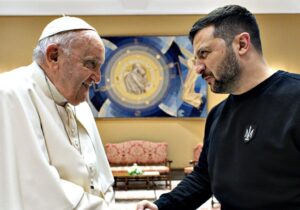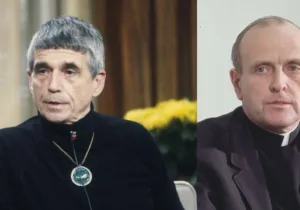Every fall, we undergraduates at University of Virginia had the opportunity to watch the classic Nazi propaganda film Der Triumph des Willens or The Triumph of the Will. Given to the film by Leni Riefenstahl, the young woman who masterminded it, the title referenced the teachings of nineteenth-century German philosopher Friedrich Nietzsche.
The film begins in 1934 as a “documentary” of the huge Nuremberg rally of the National Socialist German Workers Party (NSDAP)—the Nazis. Riefenstahl’s cinematic techniques were so advanced that they would not be used in America until the 1960s. To start, the film opens with a tri-motor Fokker airplane droning through the clouds above the feudal rooftops of the city. The sight is stunning. To the Germans, it was breathtaking. Few of them had ever flown in an aircraft, and none but steeplejacks had seen this Medieval beauty from above.
Perhaps inspired by President Franklin D. Roosevelt’s dramatic flight to accept his party’s nomination in Chicago, Hitler had delighted his followers by conducting his campaign for President of the Weimar Republic by flying. “Hitler over Germany” was the theme of those campaigns—and of this film.
The party banners had been patterned on those of the Roman legions, but Hitler the Führer was a man all modern. Never to be seen on horseback, he descended from his aircraft to enter his long black Mercedes limousine. Standing upright in the back of his auto, Hitler is the center of all activity. The film shows masses of rally attendees, arms raised in the party salute, their attention locked on their leader.
Military units take part in this partisan affair, as do peasants with their spades and rakes. The night time portions are lighted by torches. Looking down on the swirling Swastika formation of the torchbearers is a giant Iron Eagle, symbol of the resurrected German Reich.
Our UVA history professor, Oron J. Hale, presented this epic every autumn. In America, it is the season of not only football games and pep rallies, but also bonfires. Dr. Hale knew his subject well, having been the allied State Commissioner for post-war Bavaria. He had interviewed the prisoners, Hitler’s Luftwaffe chief, Herman Goering, and the Führer’s Foreign Minister, Joachim von Ribbentrop. Both of these top Nazi figures would meet their deaths at this same city of Nuremberg after being convicted of war crimes in 1946.
Professor Hale had a purpose in showing us this film. He taught us that even a nation as civilized and advanced as Germany could be mesmerized by a skilled demagogue like Hitler. And the fact that the Führer had been just a lowly corporal in the First World War only added to his appeal.
Hitler’s message was one of Vergeltung—Vengeance. He denounced all the past leaders of the Kaiser era. It was a strong motivator among a people who felt crushed and abused by the upper classes. Hitler pushed the idea of the “Stab in the Back.” Millions of Germans believed that their country had not been defeated militarily because no foreign troops had set foot in their Vaterland. They called their myth Dolchstosslegende, meaning a stab in the back by Socialists and Jews.
By the time this film was made, tens of thousands of German Socialists and Jews had been packed off to the concentration camp at Dachau. Professor Hale taught us the use Hitler made of his 1923 Putsch in Bavaria. Far from being a disgrace with a failed attempt to overthrow the elected government of that state, Hitler’s Nazis made it a centerpiece in their achievement of power. In his book, The Captive Press in the Third Reich, Oron J. Hale showed how a cowed media in Germany accepted restrictions imposed by the new Hitler government, beginning in 1933. Hitler’s techniques were Die Luge, Der Angriff, and Der Wutausbruch.
In English, these are the Lie—keep telling lies so fast and so outrageous that no one can catch up with them. The Attack is to change the topic by finding another focus of attention when a lie is revealed. Like prisoners of war, for example. Finally, there is the Rage. Most political participants live in an atmosphere of civility and cooperation—even with bitter opponents. Confronted by vein-popping screams, they are undone. They cringe. Professor Hale warned us of the dramatic impact of spectacular visual effects. At the 2016 Republican National Convention, then Republican nominee Donald Trump appeared on stage coming out of a Night and Fog. Many thought it was a reference to professional wrestling, but it actually was prefigured in the film Triumph by a leader coming out of the Nacht und Nebel. Oron J. Hale’s long-ago autumn presentations were his triumph. Showing us Triumph of the Will was no glorification of the crimes of the Nazi regime. Instead, it served to show us how attractive the demonic and demagogic can be. It is a lesson for our time.





